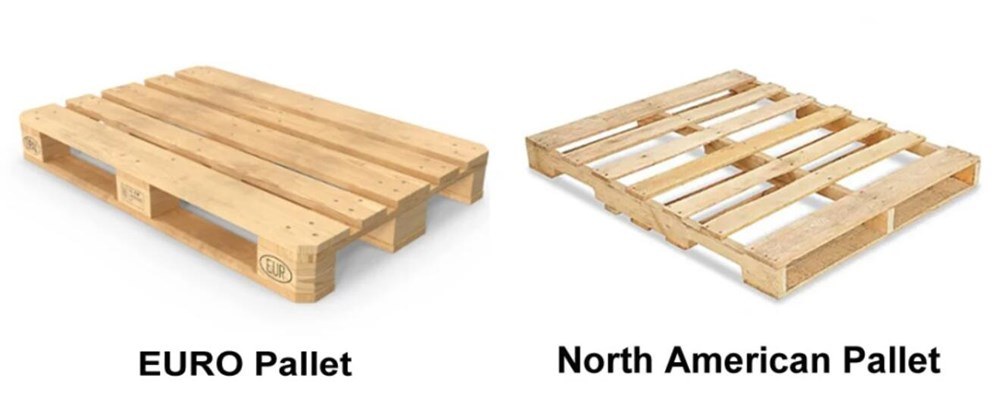The European pallet and the American pallet are both used for storing and transporting palletized goods in and out of a warehouse. The main difference between the two load carriers is their dimensions: the European pallet measures 1,200 x 800 mm, while the American pallet is slightly wider, measuring 1,200 x 1,000 mm.
Although these are the two most common pallet sizes, the International Organization for Standardization (ISO), the entity that regulates dimensions, also has established other sizes such as 1,165 x 1,165 mm, 1,100 x 1,100 mm, 1,067 x 1,067 mm, and 1,016 x 1,219 mm.
European pallets
The European pallet, also known as the Euro pallet or EPAL (an acronym for European Pallet Association), is the most widely used palletized load base in Europe. Regulated by the quality standard UNE-EN 13698-1, the European pallet measures 1,200 mm in length and 800 mm in width. These dimensions are suitable for standard-sized plastic and cardboard boxes, making it easy to group goods.
The Euro pallet is the most common pallet model in Europe and can be used in any storage system, as long as its skids are supported at a right angle to the rack beams. This pallet model can support loads of up to 1,500 kg in motion (and statically up to 4,000 kg). The Euro pallet can be handled by any type of forklift or handling equipment, making it particularly ideal for automated warehouses.
The dimensions of the Euro pallet contribute to standardized transport of goods. For example, up to 33 pallets can be placed in a trailer truck, while fewer pallets can fit in sea transport containers because the space is smaller.
Euro pallets must be marked with the EUR symbol on one side, which is an identifying mark indicating that they have been manufactured in accordance with certain quality standards. The absence of the official logo may result in the cargo being rejected, or even in the supplier or receiver of the goods being penalized by the competent authorities.
American pallets
American decking, also known as universal decking, is the dominant decking model in markets such as the United States and Japan. Standardized under ISO 3676, this type of pallet has facilitated global trade and export of products.
The universal pallet shares the same length as the European pallet (1,200 mm) but is wider (1,000 mm). The difference between the two pallets can be detected at a glance: the American pallet has a squarer appearance than the European pallet. The physical characteristics of the American pallet make it ideal for transporting liquid substances. The wider surface area of the pallet provides more stability during the movement of this type of goods.
Although the American pallet is the most popular model in the United States, there are several standard dimensions depending on the industrial sector (beverage and food, automotive, military or chemical and pharmaceutical industry, among others).
Differences between European decking and American decking
The main difference between European and American pallets is their dimensions. American pallets are wider, which makes them ideal for transporting liquid cargoes as they offer greater stability.
Another significant difference is the entity that regulates the design and manufacture of pallets. American pallets are governed by the ISO (International Organization for Standardization) standard, while Euro pallets fall under the European standard UNE-EN13698-1:2003 “Specification for the production of pallets. Part 1: Specification for the construction of flat wooden pallets of 800 mm x 1,200 mm.”
Choosing the right pallet for your warehouse
Although the European pallet and the American pallet have the same function, they differ in characteristics such as dimensions and regulation in the manufacture and marketing of these load bases.
Efficient logistics planning begins with decisions such as choosing the correct type of pallet to use in the warehouse, as well as the material from which it is made. Factors such as the supplier’s origin, the type of storage system, and the handling equipment will determine the choice of one type of pallet over another.
If you lack the necessary information to make these types of decisions, you can always delegate such responsibilities to expert services in the field, such as Xborder, which has over ten years of experience in this area. The team at Xborder will allow you to forget about such worries and focus on what truly matters: growing your business.So, don’t hesitate any longer! Visit www.xborder.co and let experienced professionals take care of the job.









